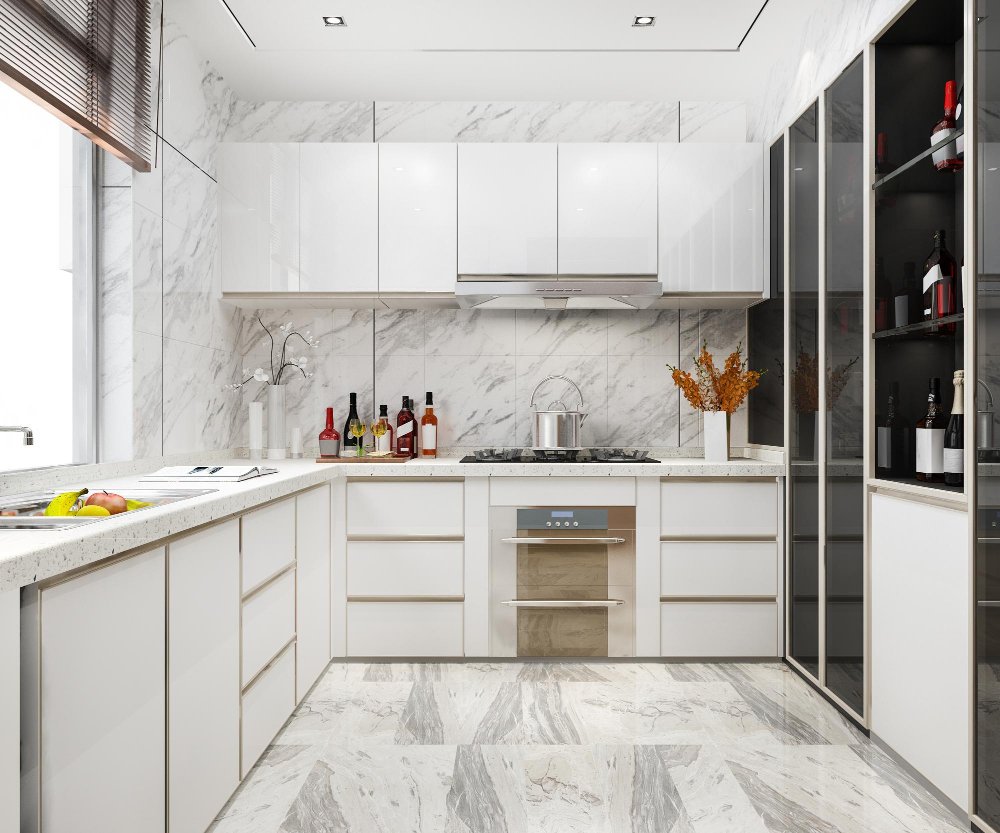
How to Design a Modular Kitchen: A Step-by-Step Guide

Introduction: The kitchen is often called the heart of the home, and in today’s fast-paced world, modular kitchens have become the go-to solution for creating highly efficient, organized, and aesthetically pleasing spaces. At Interio, we understand that designing a modular kitchen is more than just arranging cabinets—it’s about creating a space that fits your lifestyle, maximizes functionality, and adds beauty to your home. Here’s a step-by-step guide to help you design the perfect modular kitchen.
- Plan Your Layout: Functionality First
The layout is the foundation of any kitchen design. Begin by assessing the available space and choosing a layout that best suits your needs. The most common modular kitchen layouts are:
- L-Shaped Kitchen: Ideal for maximizing corner space and offering flexibility for storage and cooking.
- U-Shaped Kitchen: Provides ample counter space and storage, perfect for larger kitchens.
- Straight Kitchen: A simple, space-saving layout for smaller homes.
- Island Kitchen: Great for open floor plans, offering extra prep space and storage.
- Parallel Kitchen (Galley Kitchen): Efficient for narrow spaces, with cabinets and appliances along two walls.
Tip: Keep in mind the “work triangle” concept, which focuses on the positioning of the stove, sink, and refrigerator for efficient workflow.
- Choose the Right Materials: Balance Durability and Style
The materials you choose for your modular kitchen should balance durability, maintenance, and style. Opt for materials that are easy to clean, heat- and water-resistant, and long-lasting. Some popular choices include:
- Countertops: Quartz, granite, or laminate for durability and easy maintenance.
- Cabinets: Laminates, acrylic, or membrane finishes for a sleek, modern look.
- Backsplash: Tiles, glass, or stone for easy cleaning and aesthetic appeal.
Tip: At Interio, we always recommend selecting materials that match your lifestyle—whether you love to cook or prefer a low-maintenance kitchen.
- Maximize Storage with Smart Solutions
Modular kitchens are known for their efficient storage options. Design your kitchen with enough storage to avoid clutter and make it functional. Some smart storage solutions include:
- Pull-out cabinets: Ideal for storing spices, oils, and condiments.
- Corner carousels or magic corners: Utilize hard-to-reach corners for storage.
- Drawer organizers: For cutlery, utensils, and kitchen tools.
- Tall units: Perfect for storing groceries, cookware, and appliances vertically.
Tip: Customizing storage solutions based on your needs ensures that every inch of space is utilized effectively.
- Focus on Lighting: Combine Task and Ambient Lighting
Lighting is an often-overlooked but essential element of a modular kitchen design. Proper lighting can make your kitchen more functional and visually appealing. Consider:
- Task lighting: Bright lights focused on specific areas like the countertop, sink, or stove.
- Under-cabinet lighting: Adds an extra layer of light and ambiance.
- Ambient lighting: Overhead lighting that illuminates the entire kitchen, often combined with decorative fixtures like pendant lights.
Tip: Using a mix of task and ambient lighting ensures a well-lit kitchen that’s both functional and inviting.
- Choose Appliances and Fixtures Wisely
Selecting the right appliances for your modular kitchen is crucial to optimizing both space and efficiency. Opt for built-in appliances like ovens, microwaves, and dishwashers to maintain a seamless look. Consider these tips:
- Energy-efficient appliances: Go for energy-saving options to reduce your electricity consumption.
- Compact and multi-functional appliances: Choose appliances that serve multiple purposes to save space.
- Sink and faucet: Select a durable, easy-to-clean sink and a high-quality faucet with a pull-out sprayer for convenience.
Tip: Make sure your appliance choices align with your cooking habits and available space to maintain a streamlined design.
- Add Personal Touches with Finishes and Colors
Finally, personalize your modular kitchen with colors, finishes, and décor that reflect your style. Modular kitchens offer flexibility in color schemes, so whether you prefer a bright, bold kitchen or a more subtle, neutral palette, there’s something for everyone. Popular choices include:
- Neutral tones: White, grey, or beige for a timeless, elegant look.
- Bold colors: Red, blue, or yellow for a vibrant, energetic feel.
- Two-tone combinations: Mix dark base cabinets with lighter upper cabinets for a balanced, modern aesthetic.
Tip: Don’t be afraid to play with textures and materials—glossy finishes, matte surfaces, or metallic accents can add character to your kitchen.
Conclusion:
Designing a modular kitchen is about blending functionality with style, making it a space where you can enjoy cooking, entertaining, and spending time with family. With careful planning, smart storage solutions, and personalized touches, your modular kitchen can be both practical and beautiful. At Interio, we specialize in creating customized modular kitchens that fit your space, budget, and lifestyle. Contact us today to start designing your dream kitchen!

